Films
Paper Paintings
The layers of storytelling in María Berrío’s washi works
- 3 September
- Issue 14
- This article was produced to accompany a short film, María Berrío: Washi (2025) directed by Jason Evans, shot on location at María Berrío’s studio in New York and Mr. Maruyama Yushindo’s workshop in Osaka.
- Related Artist
- María Berrío
For the latest film in our Material series, we take a closer look at María Berrío’s transformations of washi. Since discovering the rich textures and colors of traditional Japanese papers in 2007, Berrío has combined watercolor and collage with the material to create intricate, layered paintings.
In her debut exhibition with Hauser & Wirth, “Soliloquy of the Wounded Earth,” Berrío’s large-scale canvases portray environments and characters that are at once unknown and familiar. Drawing from both her childhood in Colombia and her life in New York City, her scenes merge myth and folktale with the rhythms of contemporary life, tracing moments of challenge, resilience and quiet triumph.
For Ursula, Jason Evans sat down in her Brooklyn studio to discuss her process, her enduring fascination with washi, and the ways her new works continue to explore the intersections of culture, memory and imagination.
Jason Evans: There’s a range of materials in your work that I’m curious about, but I thought we might start by talking about Japanese paper.
María Berrío: I’ve been collecting different kinds of Japanese paper for the past ten years. One of my best friends is from Japan, and she introduced me to them. I didn’t like painting so much, and so I didn’t like the material of paint. She said, “Why don’t you paint like you dress?” I used to dress with a lot of patterns. “Why don’t you use Japanese paper?” she said. And so I started to work with different kinds of Japanese paper, like washi and yuzen and katazome. I begin by drawing, and then I build the painting with the papers.
JE: What do the different Japanese paper styles have to offer?
MB: At first, I was working with katazome and yuzen, which are machine-made and have a lot of pattern. But then I wanted to make my own patterns. With washi, there were so many different possibilities. Some of the sheets are very thin, and some very thick. Some have a different feeling and color. Most of their colors come from flowers, and are handmade. So there is a sensibility and beauty already in the paper, which I love.
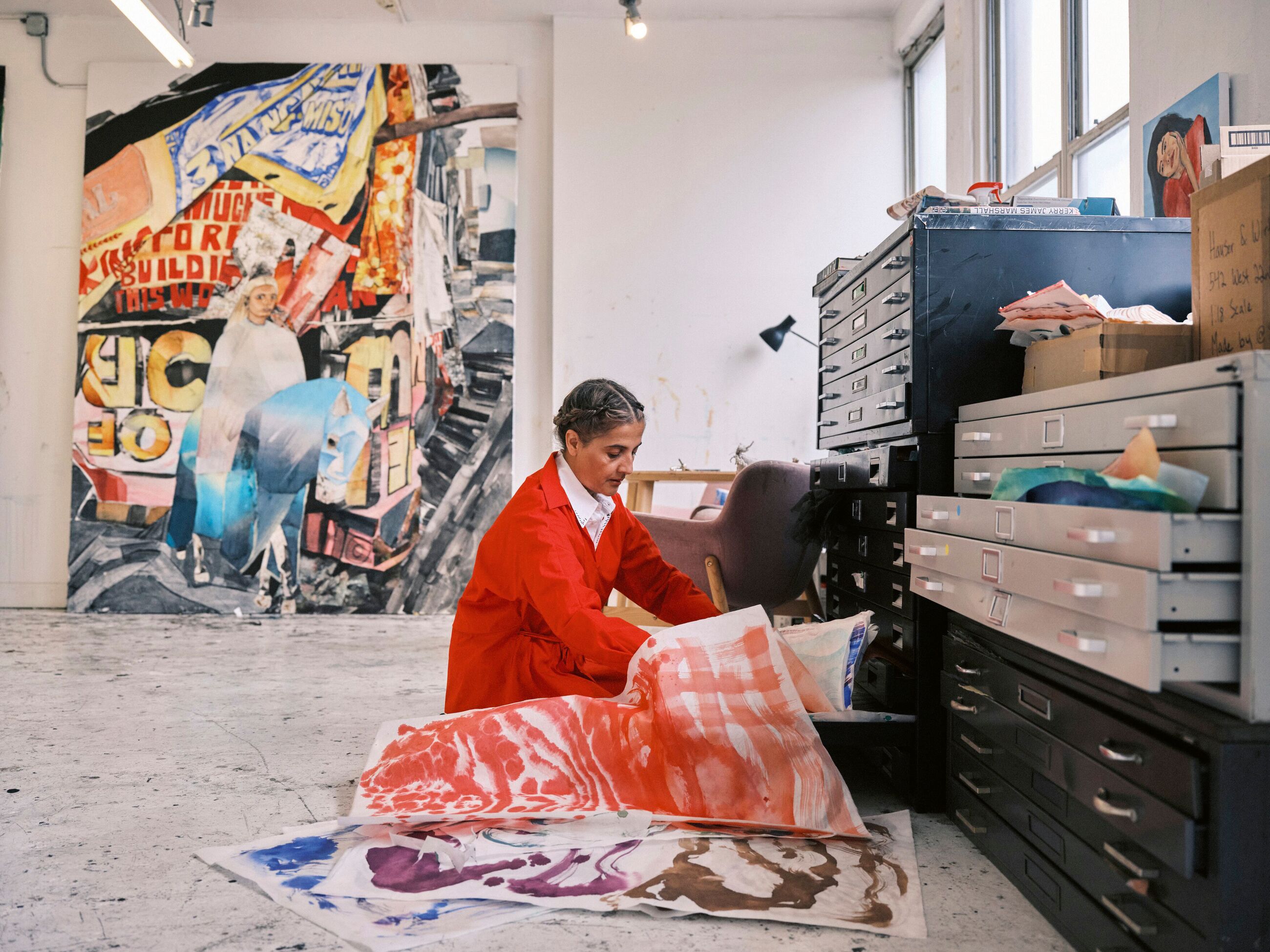
All photos: Brad Ogbonna
JE: It seems like a lot of care goes into the paper. Do you know how it’s made?
MB: Yes, the paper is already a piece of art itself. The pulp is made from the bark of trees and plants, which is then dried in bamboo crates. Sometimes it’s dried over wood, which gives the paper the texture of wood. Sometimes real flowers are added. There are many different techniques for making Japanese paper. In the studio I have maybe 10,000 different kinds of papers I’ve collected over the years. The paper makers come from a long tradition of this work. For them, it’s like an art form. When the paper comes into the studio, I value the care that it already possesses and try to respect the material as much as I can. At the same time, I also want to reinvent its possibilities, so I look for many ways of reusing this material. I tear and cut and create different compositions, letting the paper guide me.
JE: Obviously there is a distinction between tearing and cutting the paper. How do you decide which technique to use?
MB: I like to lay the papers on the floor of the studio, which can sometimes be hundreds at a time. I’ve developed a library in my head of all the papers I’ve collected from traveling to Japan and from working with my fabricator, and it’s almost like a palette of paint. I can start to pull papers from the ground and see where they belong in the work. But all the decisions of cutting or tearing are very physical. The way I tear is almost how someone would apply a large brushstroke. And then I use an X-Acto knife to get closer, and create details in the work. I’m enamored of the edges of the paper. The edges serve as a kind of map for how the composition will come together.
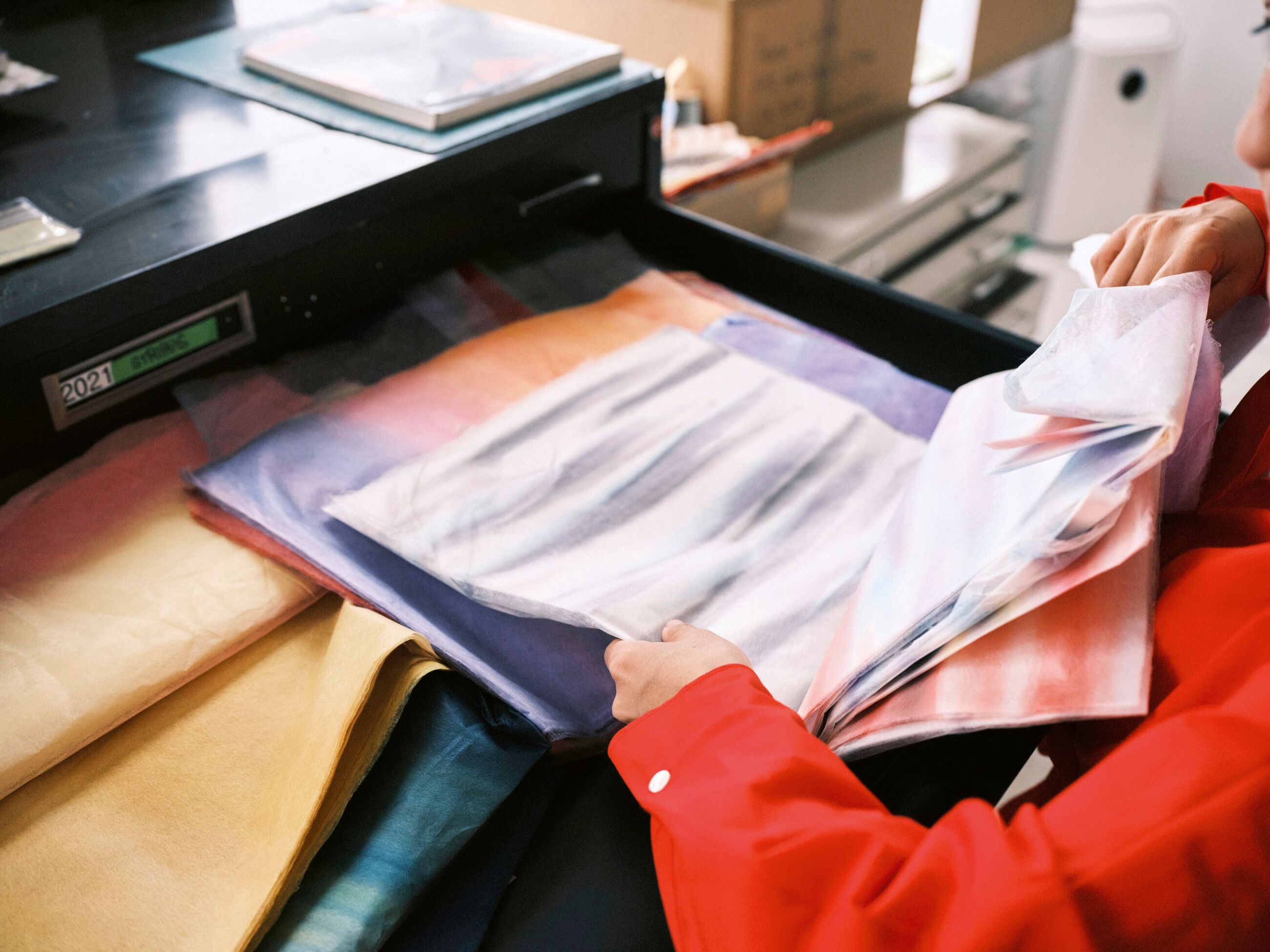
JE: Which is a possibility created through collage as well?
MB: Yes, the possibilities of the paper are what create the work. With collage, the layers of ideas and stories create a world.
JE: The physicality is something you can actually see in the finished work, in the layering and the texture of the paper.
MB: I think the physicality of using the paper is very important. Lately, I’ve tried to let the work be more expressive, and so it becomes more physical in the sense that I have less control. It is more intuitive. There is also the act of tearing, or of using the X-Acto knife to cut something, which also feels very physical.
JE: You have so many X-Acto knives in your studio. How often do you go through them? What’s your relationship with this tool?
MB: I feel like my paintbrush is the X-Acto knife. I order over a hundred every month. Sometimes I can use a blade only once, because the second time it won’t cut the same way. There are all these little rules and methods that I have developed in the making of these works. Even the way I apply glue to the canvas is important. Before, I would use my hand, but now I use these beautiful brushes from Japan that bring a fluidity to the glue when I’m preparing the canvas for paper.
“I like to lay the papers on the floor of the studio . . . almost like a palette of paint. I can start to pull papers from the ground and see where they belong in the work.”—María Berrío
JE: Where do these other materials, such as glue and charcoal, come into your process of creating a work? Do you begin right on the canvas, or in a sketchbook first?
MB: The work starts very intuitively. I am fascinated by the blend of myth and reality. So my first steps are in finding what interests me and what story I am going to tell. I start by drawing from my imagination or by using a model. I never really know what to expect from a painting, but I kind of let my intuition and the material guide me. The painting could start with the idea of a landscape and then become a cityscape. The process lets me know what step to take next.
JE: It’s interesting because the process of layering is not always apparent when you’re first looking at one of your works. In the photographic documentation, as well. You don’t always see the layers.
MB: Some of my early works had twenty layers of paper. Now that I am a bit more knowledgeable of the materials, I have a better sense of what papers to use. So the pieces have become less layered and more expressive.
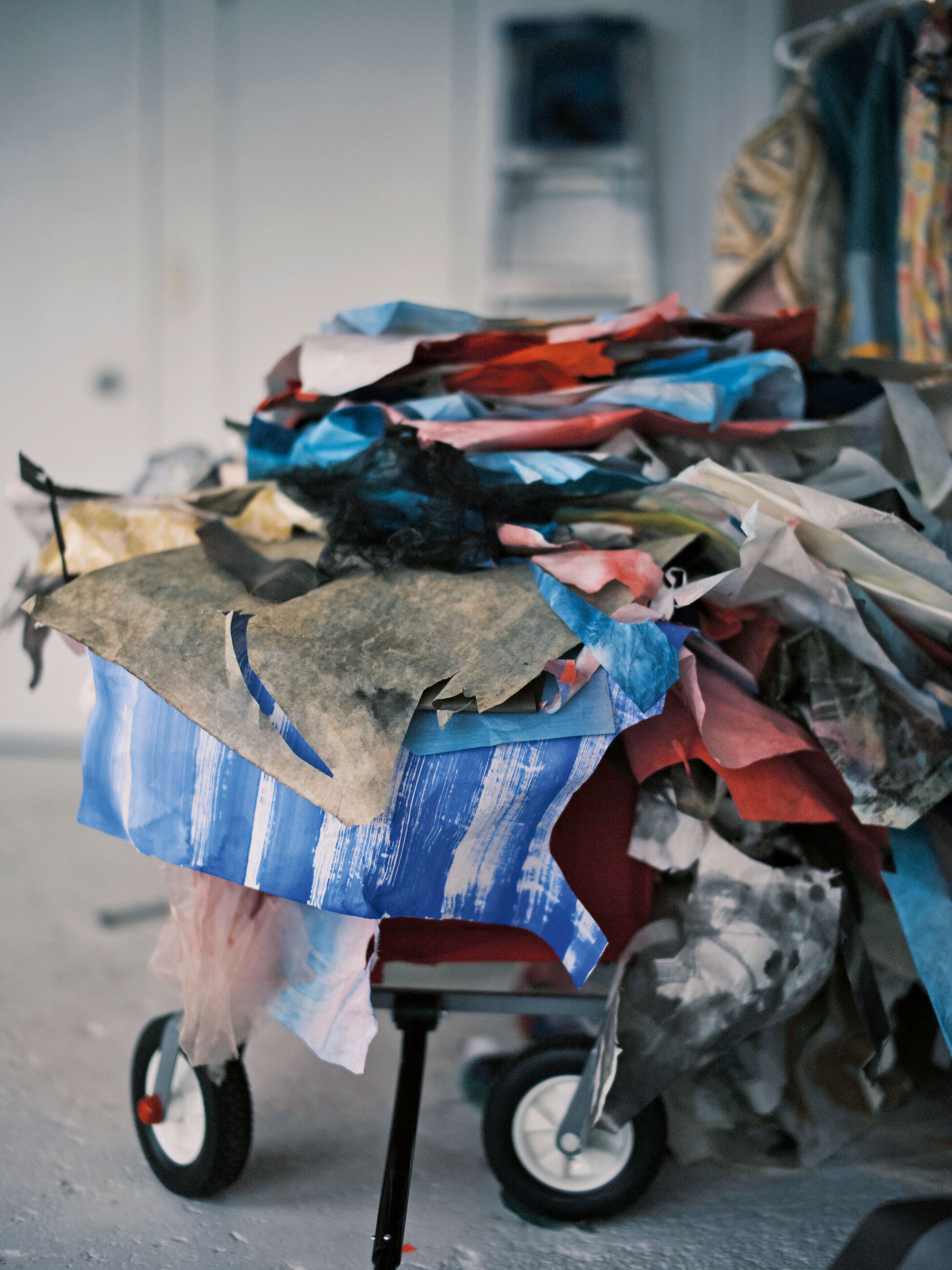

JE: In an interview, you said that some of the worlds you create are inspired by dreams.
MB: Yes, sometimes I’ve written my dreams and then made them into paintings. A lot of the worlds in my work are populated by familiar faces, but also by otherworldly characters. So in the end, the works become quite dreamlike, even if I have a story to tell. I do feel that, for artists, one of our missions is to touch other worlds. In my work, I try to reveal this sense of mystery that I find through art-making. My hope is that the viewer can access that mystery while looking at the work and realize there isn’t an answer for everything.
JE: Could you talk about this kind of world-building in relation to the new series for your upcoming exhibition, “Soliloquy of the Wounded Earth,” and some of the thoughts and influences that guided it?
MB: For the new series, I imagined a story in which humankind steals the threads from the Three Fates. In the myth of the Three Fates, one of the Fates spins the thread, one measures the thread and the other cuts the thread, ending a person’s life. So humankind steals the threads and weaves them into banners and worships them, and the consequence of this is war and destruction. I was thinking about destiny, and what the world would be like if humankind could control its own.
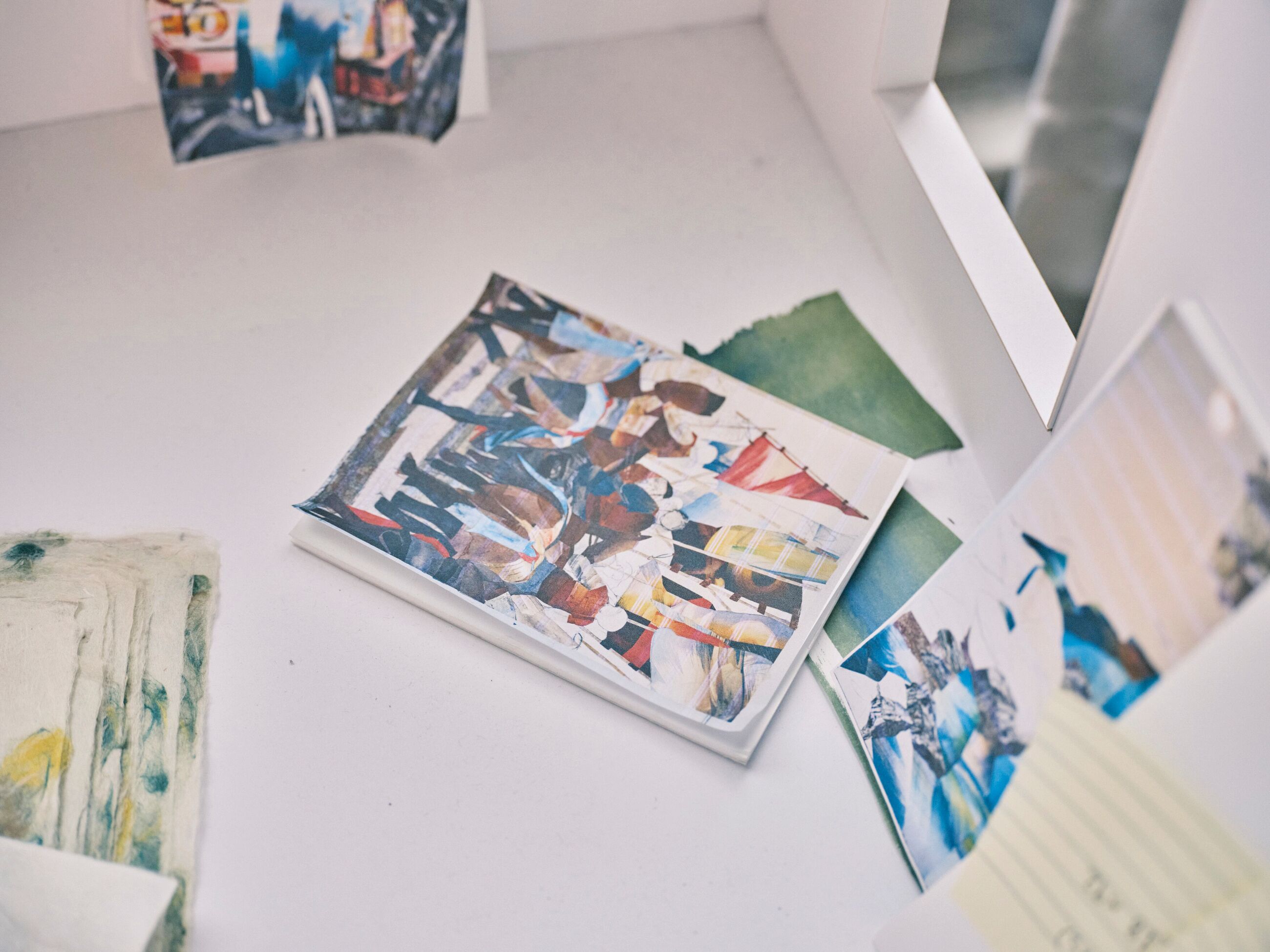
JE: There’s an interesting connection, or cross-over, as well, with the materials you’re working with.
MB: Yes, definitely. The materials also kind of led to this story as I was constructing them. In the way that I use storytelling as a thread to connect one word to another, I am also connecting works. Of course, these stories are a reflection of my thoughts and feelings in the time of their making, and become personal to the viewer in the end. I want people to enter the gallery and feel like they’re part of this created world and can have their own questions and their own answers as they walk through these very large pieces.
JE: Natural motifs such as the sky, sea and birds appear and reappear in your work. In the new series, horses seem to be very prominent. How do you see nature in your work?
MB: I grew up in Colombia, where I was surrounded by nature, so there is some sense of longing for that beauty while living and working in New York City. But the animals are also symbols that I use to tell stories. The repetition of birds and horses represents freedom and migration. Nature comes into the work as a way of reflecting the continuation of life and showing that nature is bigger than humankind.
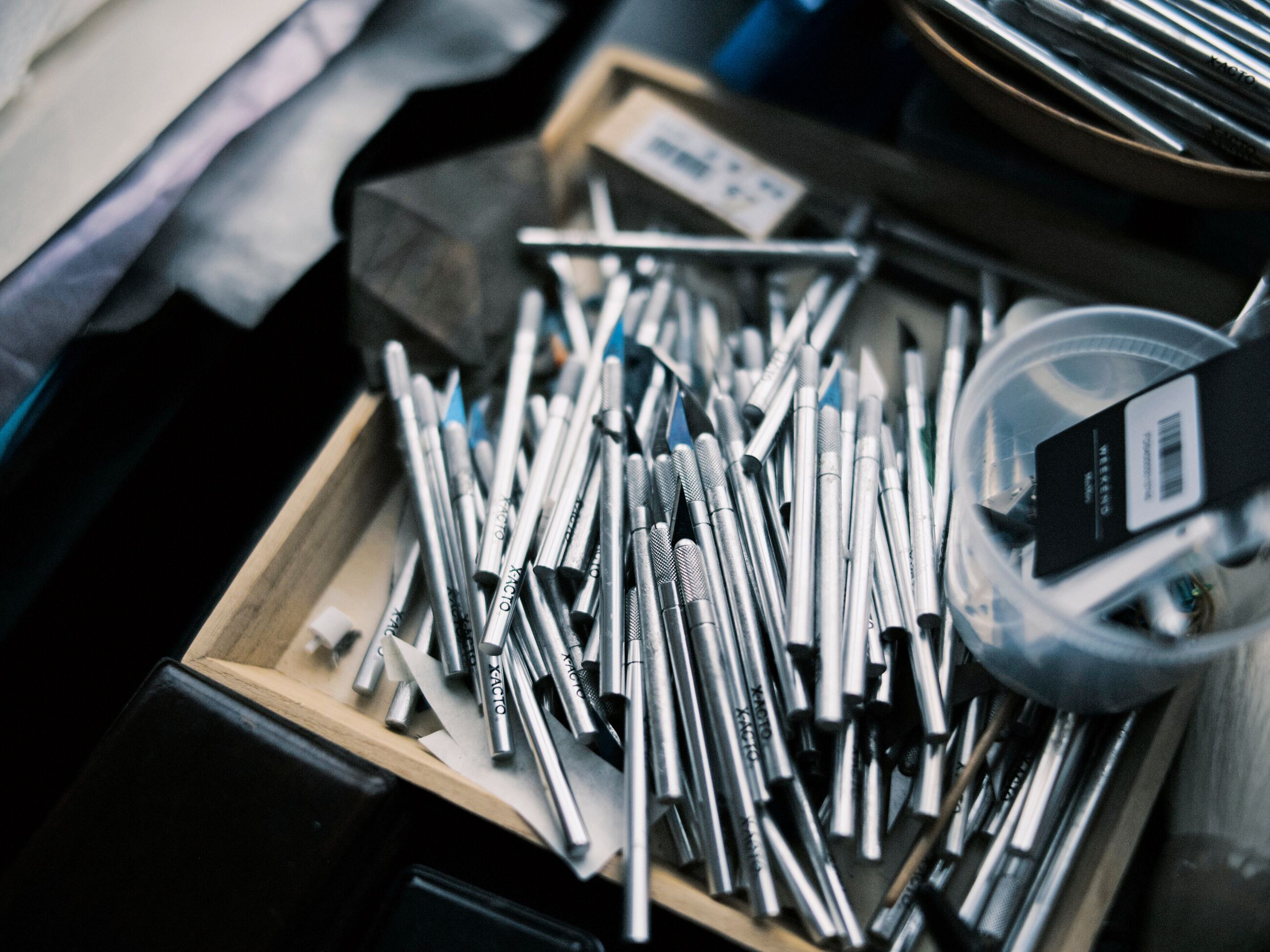
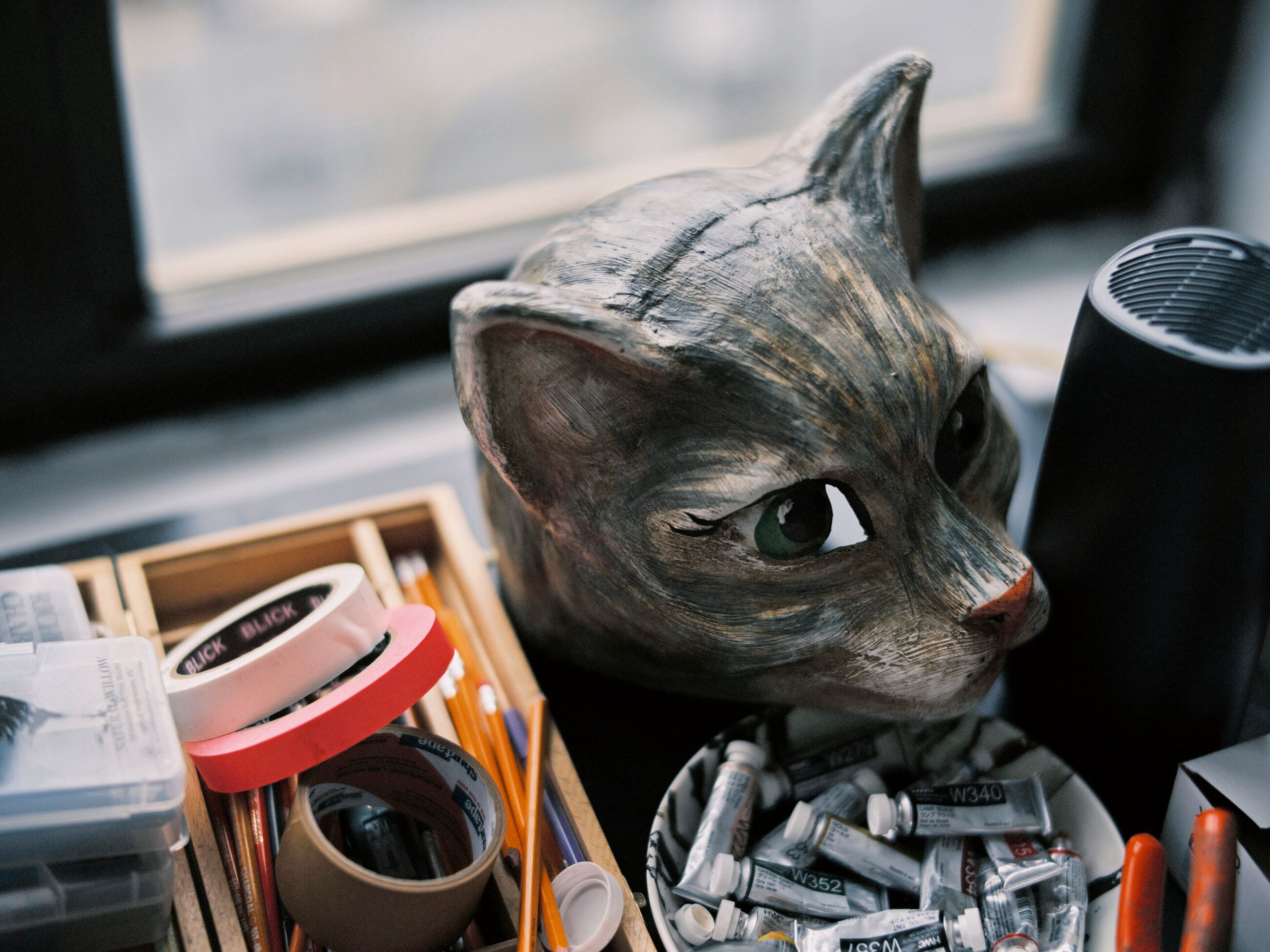
JE: So you have these bird and horse motifs in your work representing migration, and then of course there’s your own migration from Colombia to New York. How have those two places, and your immigrant experience, influenced your work?
MB: I grew up in Bogotá during the ’90s, which wasn’t the best time to be there, but we had a farm by the mountains where I spent most of my childhood. When I came to New York for college, it was the opposite of what I was used to. It was chaotic, and there were so many people. But then I fell in love with New York. I fell in love with the idea that you can feel invisible and also a part of it all, like everything around you. I think that if I was in Colombia, I would probably be painting buildings. These two places are polar opposites.
There was a series of work in the past where I talked about migration and used the symbolism of a bird, or of this creature that I created, which was called “The Nightingale,” half woman, half bird. It kind of represented my own experience as an immigrant, with the idea that a thing that makes you different can be your power. It can be what makes you take flight. The characters in my work that are a little bit otherworldly relate to what it feels like to come from somewhere else and be living in this country.
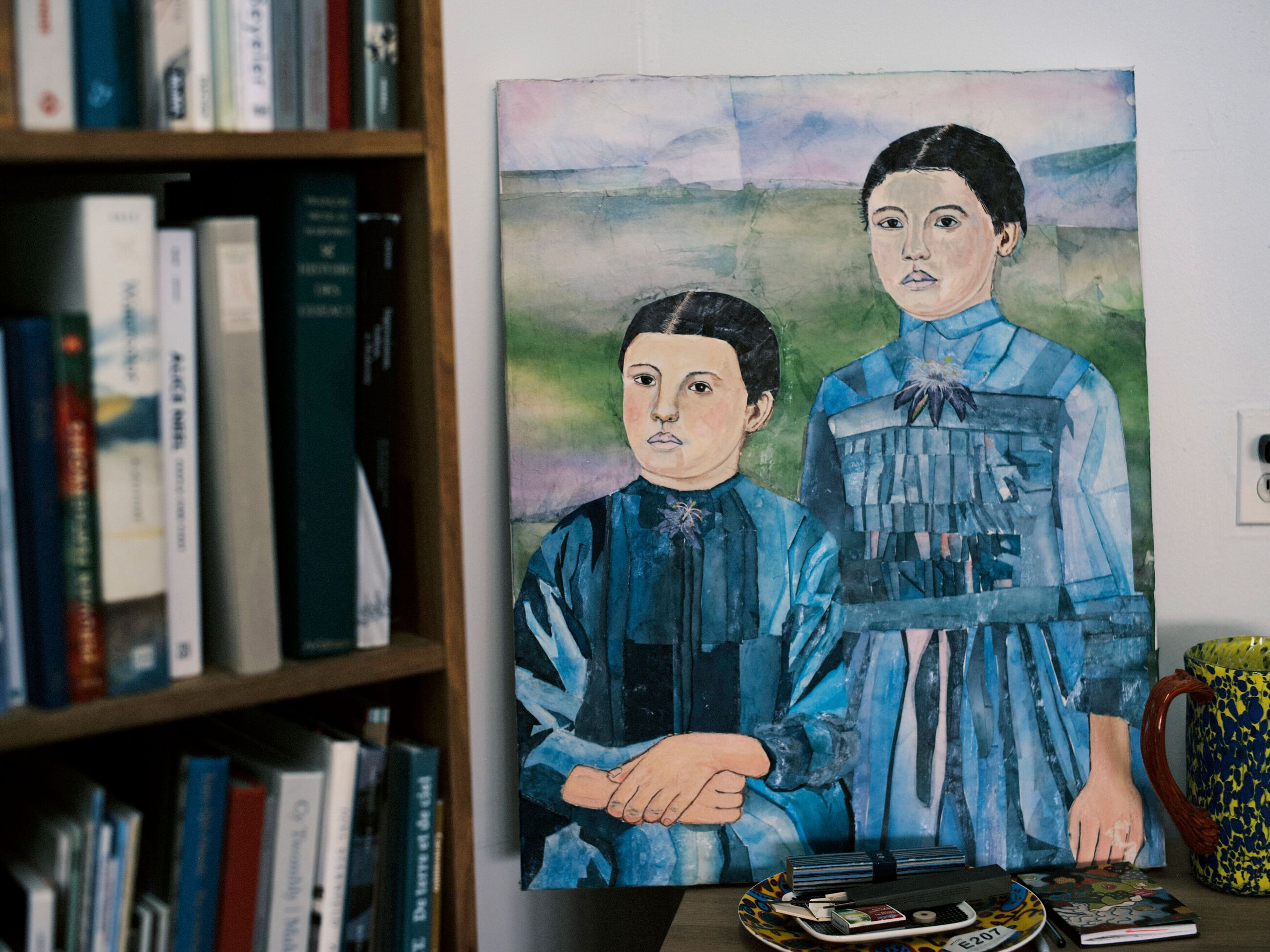
JE: Do you remember seeing art, growing up in Colombia?
MB: We didn’t have so much art, but there was music. Every morning my father would play Gregorian chants to wake us up. My experience was more guided by music than by art, but I think that there was so much joy, and I think that joy is really what drives me to make the work.
JE: This makes me wonder what kind of conditions you set for yourself when you go into the studio. Do you have any rituals? How do you prepare yourself to work?
MB: Lately, listening to opera has felt important for the work. Not only listening to it, but going to the opera and going to the ballet as well. Having the right music on while I’m painting is part of my preparation to keep fear away, as much as possible. When I’m working, I try not to think so much about making something that is going to go out into the world, but to see it as a world in itself that I can’t control but am willing to face. I try to just let the work be whatever it wants to be.
“The possibilities of the paper are what create the work. With collage, the layers of ideas and stories create a world.”—Berrío
JE: And some part of your process can involve working from models? In the new series, you’re collaborating with dancers.
MB: Yes, I’ve started working with a dance company called Gallim, and their choreographer, Andrea Miller. It was very refreshing to work with dancers, because I’m usually working without a model. I was able to dress them, and I had them wear masks and makeup. It was like seeing the world of my paintings come to life. It gave me the idea that my work could be very theatrical, and that this theatrical aspect of my imagination could also inspire the works. I try to balance both imagination and reality. It’s interesting when a face that comes out of my head will appear somewhere else, in another painting. I start to feel the mystery of art and where it comes from. It’s like these characters that live in my head visit the works to tell a story. But including aspects from reality brings other important elements into the work. So I try to play between both worlds.
JE: When you’re working with models, are you also looking for certain gestures and shapes of the body?
MB: When I worked with the dancers, I gave them a set of stories to perform or movements that I wanted them to be making. But a lot of it was also just seeing how all of these different costumes I have been collecting were layering and interacting. The masks created this otherworldliness, and the models just lost their identity. You couldn’t tell who they were. It was really beautiful to see how the costumes and the masks created their own story.
“I do feel that, for artists, one of our missions is to touch other worlds. In my work, I try to reveal this sense of mystery that I find through art-making.”—Berrío
JE: The masks—I’m thinking of the cat mask—are similar to how you described the papers as works of art themselves.
MB: Yes, some of the masks, including the cat mask, I found in Venice in a very old shop. The cat has become somewhat of a recurring character, almost like a trickster, in my work. Over the years, these different characters have come into the work, and I feel like the more work I make, the more opportunities they have to visit.
JE: In terms of the storytelling in your works, how do you go about it? Do you begin with the story in mind?
MB: I usually work in the studio with around eight pieces at a time, and one painting informs the other. Once I have three going on, I know what’s going to happen. The paintings are informed by each other, as well as by the materials that I have at that moment. The beauty about using paper is that I could never recreate the same painting, because it would be impossible to source the same materials. Every painting is unique in that its papers have been sourced at different times of my life, from different fabricators and places in Japan I wouldn’t know how to find again.
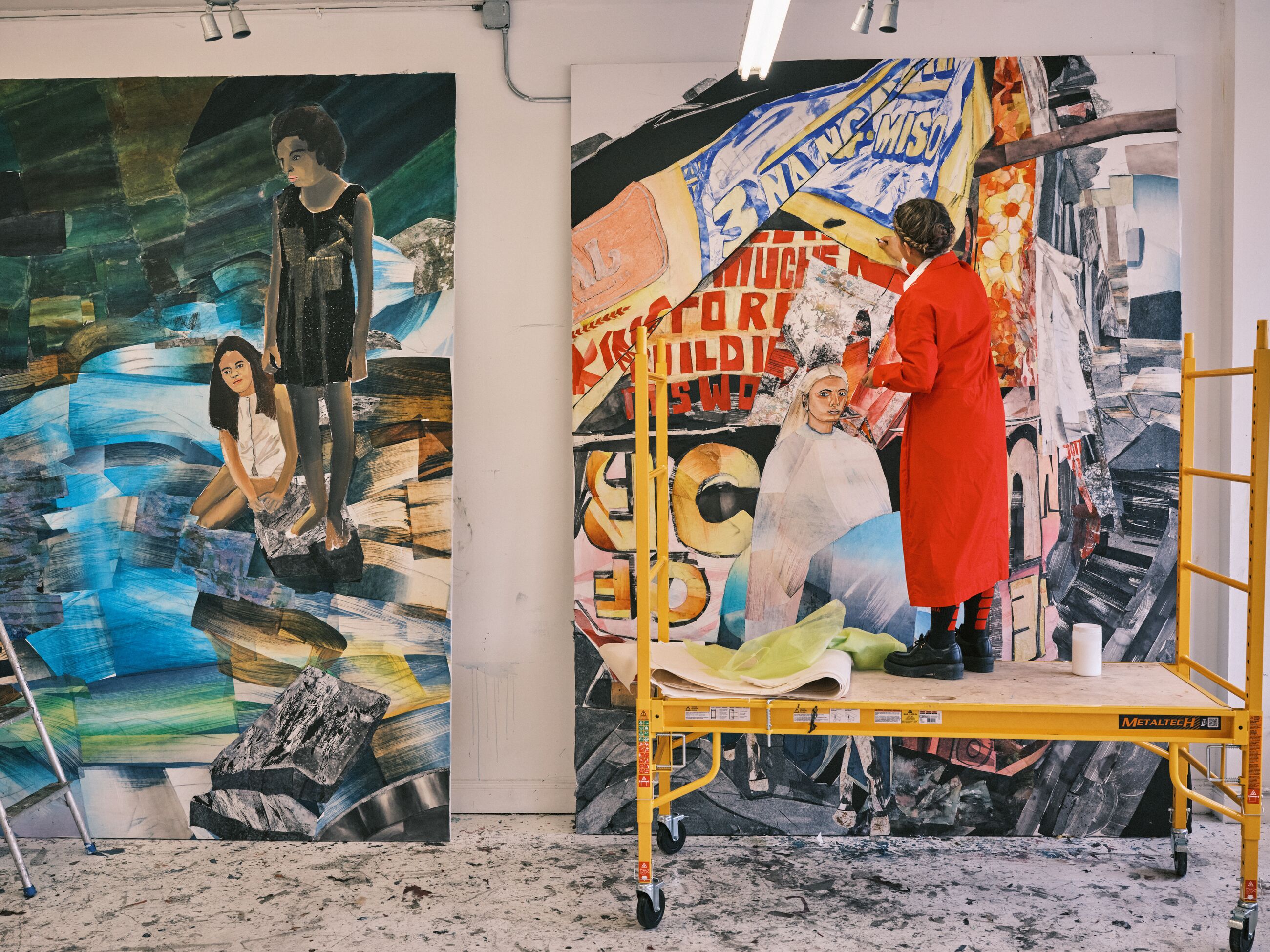
JE: And I suppose, too, that some of these papers are made as one-offs?
MB: Yes, most of the papers are handmade and may not be made in the same way again. The paper is already a piece of art that you’re working with. Even though I tear them and work with them in a more physical way, I know the value in each piece of paper and I care for it.
JE: Your painting, Soliloquy of the Wounded Earth (2025), which is also the title of your exhibition, depicts a woman on a horse and a wall of flags. Is there a story behind it?
MB: A soliloquy is when somebody is onstage delivering a monologue of their inner thoughts, and I feel like that’s kind of what artists do in the studio. We create these visual monologues or poems of our thoughts. So there she is, the woman—she almost looks like a warrior, and she’s telling us how much the Earth is hurting. When I made this painting, I was feeling how wounded the Earth must feel and also how vulnerable and fragile humankind is. But when I painted her face, she had such strength in her eyes. I realized that she wasn’t revealing the pain and the violence but that she was revealing hope. It was the first piece that I created for the show, and it’s my favorite. Usually, that happens with a piece that comes more toward the end, but this one was my favorite from the beginning. So when I think about this series, I’m thinking about destiny and reconstruction and hope for humans and for the natural world.
–
María Berrío’s practice weaves elements of memory, magic and identity, drawing heavily on her youth in Colombia and her experiences living and working in New York City. Through her intricate collages on canvas, Berrío explores complex layers of identity and belonging, moving fluidly between the cultures that have shaped her.
Jason Evans is an Australian-born, New York-based filmmaker and programmer. Since 2008, he has operated the online archive This Long Century, a collection of personal reflections by artists, filmmakers, photographers, writers and poets. He has organized screenings at Metrograph, New York; Now Instant Image Hall, Los Angeles; and online for the Criterion Channel.
Brad Ogbonna is a New York-based photographer who focuses on portraiture, culture, travel and storytelling. His work has appeared in The New York Times, The Financial Times and Rolling Stone.
–
“María Berrío: Soliloquy of the Wounded Earth” is on view at Hauser & Wirth New York, 22nd Street from 4 September through 18 October 2025.
All photos taken by Brad Ogbonna.
